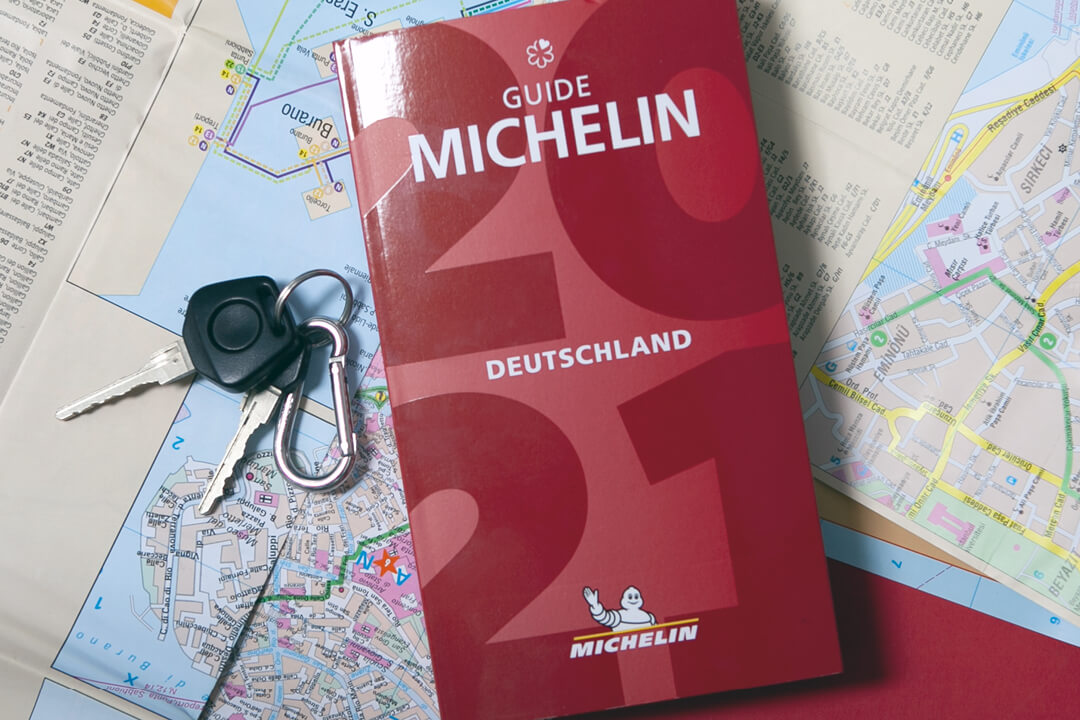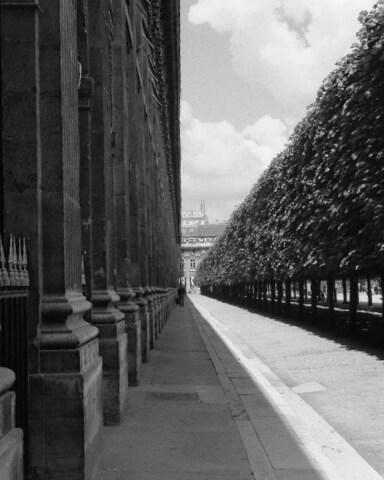Vehicle documents, driver’s license, Guide Michelin? Ready to go.
At the moment, the handbrake is still on. But as soon as it starts again, the red GUIDE MICHELIN is stuck in the tray on the right, next to the passenger seat. These days we are also leafing through our favorite book with the red cover.
The first GPS for workshop and hungry motorists
Long before any trip anticipation begins with a look at the GUIDE MICHELIN. He is known for awarding the Michelin stars. But it offers much more: reliable information about culinary highlights left and right of the road in a wide variety of categories.
The brothers Andre and Edouard Michelin, owners of the Michelin tire factory, published the first GUIDE MICHELIN in 1898 for the approximately 3000 motorists who existed in France at that time. The GUIDE MICHELIN showed them where they could find garages on their road trip.

So it made sense to include not only workshops on the maps where the automobile could be taken care of, but also restaurants where good food could be expected.
Since a glass of Sancerre or Bordeaux is a must with a meal in France, accommodation options have also been included in the Michelin Guide.
Some things cannot be improved
The GUIDE MICHELIN gets along in the paper form with maps, texts and symbols. It focuses on the quality and characteristics of restaurants and hotels. That’s what makes him so likeable.
No food styling, no photo gallery with interchangeable images that almost always show a model couple toasting with a glass of wine.
Pure information that will make anyone’s mouth water who is excited about food.
Paper versus app
The GUIDE MICHELIN is now also available as an app. Even free of charge. We only use the app as an accessory. Because we find the GUIDE MICHELIN in paper form much more efficient.
As with many apps, you spend more time with the GUIDE MICHELIN app than originally planned.
In the app, the restaurant’s web pages are linked, there you take a look at the menu and the picture gallery, click the one or other video and quickly lost the overview and a lot of time. In the end, you book enervated after a rather unsystematic search process or put the cell phone aside annoyed.
Enjoyable hiking on the map
In the paper version, you start by looking at the overall map of the country, then move on to the sub-maps of each region. There are marked hotels and the restaurants that have been awarded one, two or three stars.
However, the map features equally excellent inns with regionally inspired cuisine, the so-called Bib Gourmands. Its symbol is the always friendly smiling face of the Michelin tire man Bibendums.
Bib Gourmands usually have an excellent price/quality ratio. We have never been disappointed and often delighted.
The practiced reader of the Guide Michelin can tell at a glance whether his next car trip will take him through an area that doesn’t have much to offer in the way of cuisine, or whether there will be plenty of culinary highlights.
Culinary clusters are interesting. In areas where there are a large number of starred restaurants, you can often find less expensive restaurants run by former employees of starred restaurants. With a lot of ambition and diligence, many are working to achieve their first own star. Often an excellent choice.
In the best case all three shine
The famous tire man Bibendum, brand symbol of the tire factory Michelin beams to this day with a happy smile from the GUIDE MICHELIN. It has been slimmed down in recent decades, but its positive aura has remained the same.

Once a guest has found an excellent restaurant thanks to the information provided by the Guide Michelin, he wears the same smile on his face.
Smiles were also seen on the chefs who were awarded their first Michelin star by GUIDE MICHELIN this year. In the days of Corona, the announcement of the stars for the current edition of the Guide Michelin Germany on March 5 this year was a virtual event that you can watch on YouTube. Interesting for every foodie.
The joy but also tension of the consistently very sympathetic chefs, who were connected via tablet to the headquarters of GUIDE MICHELIN in Paris and were delighted to receive their first Michelin star, goes to the heart.
One or the other tear flows and one feels the longing of all to hopefully be able to entertain guests in their restaurants again soon.
The criteria for awarding the stars
The testers of the GUIDE MICHELIN are anonymous on behalf of the Guide Michelin. Tables are booked with different names, cell phone numbers are changed regularly, and a tester who has traveled to a particular region is not allowed to travel to that region again until 10 years later.
The tester is on the road for about 28 weeks a year, taking eight to ten meals in a week. The testers eat alone in the restaurant, which nowadays does not necessarily arouse suspicion, and are required to write a detailed, multi-page report about their impressions of the restaurant after the meal.
Restaurants listed in the GUIDE MICHELIN are regularly reviewed. Especially when it comes to awarding or removing a star, different testers visit the restaurants before the star decision is determined.
For most ambitious chefs, earning a Michelin star is a dream come true. This increases awareness enormously and the number of table bookings goes steeply upwards for the time being.
With a star, however, the pressure to at least maintain, if not increase, that star also increases. The deprivation of a star is bitter.
The Guide Michelin’s official criteria for awarding stars are:
- Product quality
- Chef know-how
- Sensitivity to aromas
- Originality of the dishes
- Consistency and consistent quality
For insiders it is clear that the service, the ambience and the wine cellar also play an important role. And rightly so, because a visit to a restaurant can only be a success if the service is excellent. And if you are lucky enough to meet a knowledgeable sommelier, the pleasure is perfect.
The fact that this year, for the first time, Michelin Germany is also giving an award for the best service is consistent.
Ambitions for a star mean a not inconsiderable investment for every restaurant, in the wine cellar, in cutlery, crockery and many other details, which quickly add up to a not inconsiderable sum and must be earned through hard work, high-quality use of goods and satisfied guests.
The statement “I’m not interested in a star, I’m only interested in satisfied guests” sounds good, but is usually just a desire for a higher profit margin.
Especially now, in times of pandemic
Anyone who has ever had a glimpse into the kitchen of an ambitious restaurant or has a chef in their circle of friends knows how much day-to-day discipline and skill it takes to produce consistently high quality in a restaurant kitchen.
Menu sequences where every longer pause in between can already lead to criticism, tables that blithely order à la carte and yet expect every dish at the table at exactly the same time, more and more special requests due to allergies and yet the fish and meat must be served exactly with the desired degree of cooking and the plate must look creative.
In any industry, quality is determined by the best. The same is true for the restaurant industry. Of course, quality is also always subjective and some days a plain good buttered bread satisfies all desires.
Michelin Recovery Index
In a world without excellent restaurants, a piece of the quality of life would be missing. On an interactive map of the Guide Michelin, one can see how many of the star restaurants are open at the moment in the so-called Michelin Recovery Index, which is updated weekly.
Opening still says nothing about the normal state, because even some star restaurants offer take-away cuisine at the moment.
Worrying about good restaurants is not a luxury in our view in times of pandemic. If you really take the statement “support your local business” seriously, you count all catering businesses that are serious about their cuisine.
From Belgium to Washington, D.C.
The GUIDE MICHELIN is available for many, but not all countries. In Austria, for example, the Michelin Guide focuses on the cities of Vienna (58 restaurants) and Salzburg (19 restaurants), and also mentions a handful of restaurants in Carinthia and Vorarlberg (5 restaurants in total).
The GUIDE MICHELIN Japan lists 442 restaurants in Tokyo, 214 restaurants in Kyoto and 207 in Osaka. With currently 209 star restaurants (including 12 restaurants with 3 stars), Tokyo stands lonely at the top of the culinary Olympus.
In Germany, the 2021 edition of the Guide Michelin lists only one restaurant with three stars: the Schwarzwaldstube (after the fire in temporaire) in Baiersbronn.
Guide Michelins, which list not only the largest cities but the entire country, such as France, of course, but also Italy, the Netherlands or Switzerland are rare and the purchase is worthwhile in any case.
Especially when driving through unfamiliar areas and hunger sets in, reaching for the GUIDE MICHELIN is a safe bet.
You can see what choices you have in each region, get an idea of the style of cuisine by listing some dishes. Symbols such as guest garden are very welcome in the summer and the price of the menu gives an idea of the price level. It is also always important to look at the restaurant’s days off.
Whether a simple inn or a star restaurant. At both, you can be lucky and get a table at short notice, especially at lunchtime, because someone canceled.
The GUIDE MICHELIN has already led us to fantastic experiences spontaneously while passing through many countries in Europe, because often very good restaurants are located in industrial parks or other areas where you would not necessarily expect them.
Tablet – Michelin’s digitization for hotels
In December 2018, GUIDE MICHELIN adopted the Tablet digital hotel guide. Here, digitization has many advantages, because the excellent image quality, the detailed description of the hotel and the sometimes themed selection of hotels (hotels for nature lovers, hotels in secluded areas, hotels with grandiose pools, etc.) arouse curiosity about a new vacation destination.
Once you’ve decided, you can further heighten your anticipation by picking up the GUIDE MICHELIN and creating your own individual dream list of restaurant delights.
Star and asterisk
A tip for great enjoyment on a smaller budget: some star restaurants have a second branch. Sometimes even in the same building only with a somewhat simpler ambience.
If you reserve a table there, you can benefit from the rigid discipline and quality of the chefs, who are often trained and operate in the same kitchen, and get excellent pleasure on the plate at a comparatively much lower price.
Thus, from Bruges to Zweiflingen, we have had the best experiences.
Are there any other guides?
Of course. Very many and more and more. It’s ultimately a matter of taste. We experimented again and again from Gault Millau to Zagat, but in the end always returned to the red book.
Depending on the specifics of the country’s cuisine, we sometimes use second guides and have, for example, discovered many a good osteria in Italy with Slow Food. Our culinary love belongs to the reliable GUIDE MICHELIN. Too many wonderful memories are stuck between the red book covers.
#advertising #independentGMrecommendation #BecauseWeLoveIt
Photographs © GloriousMe




